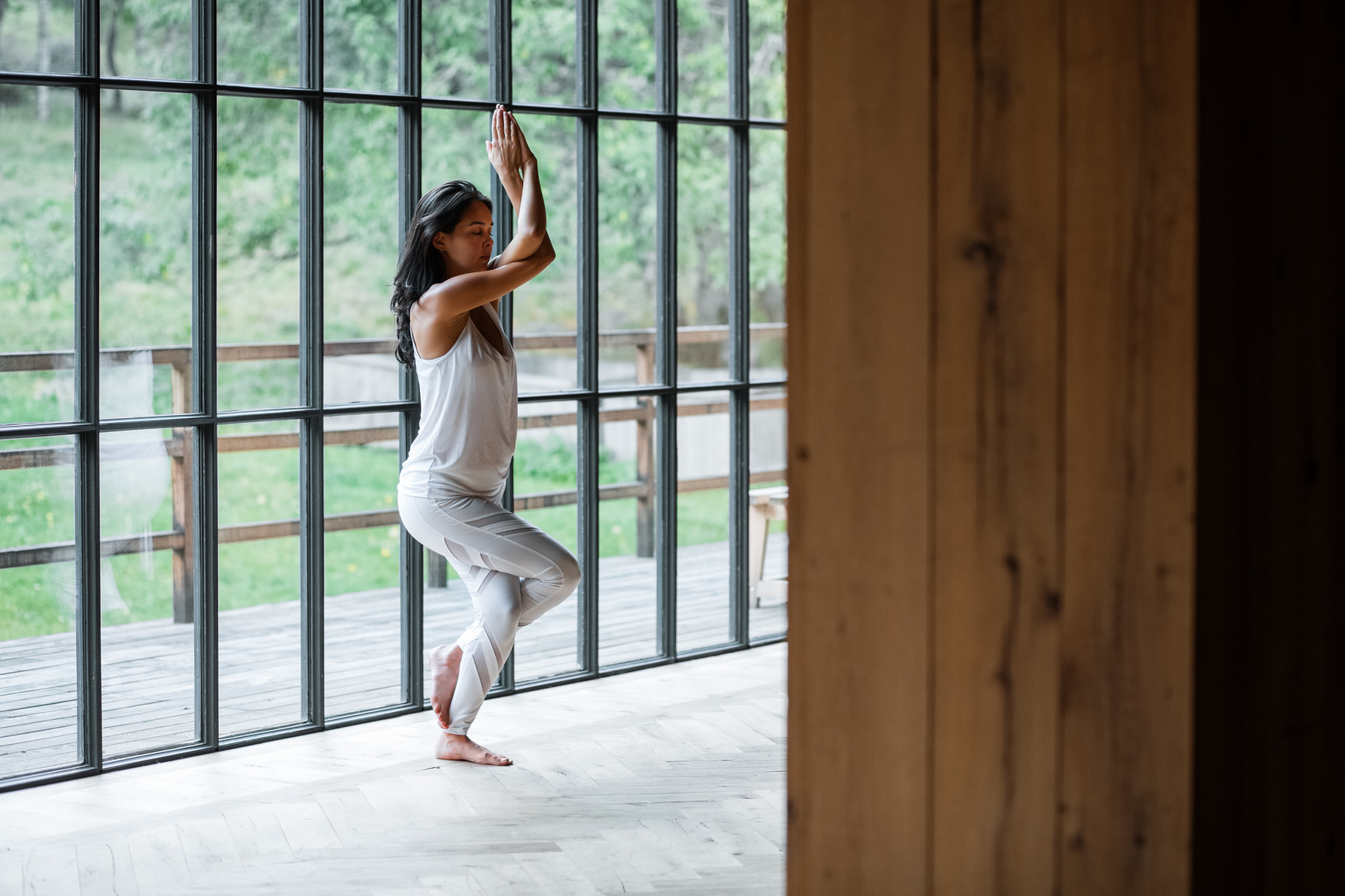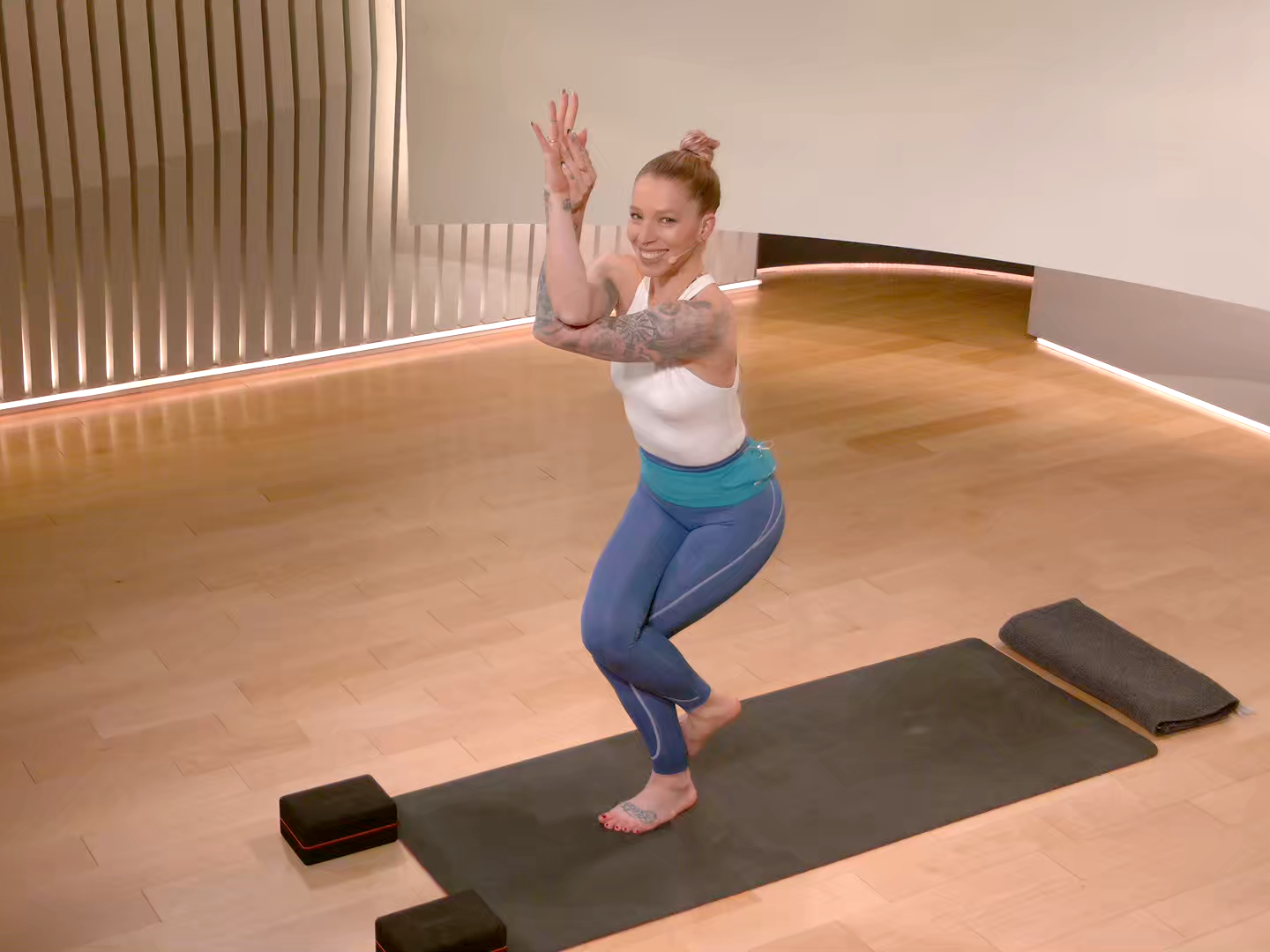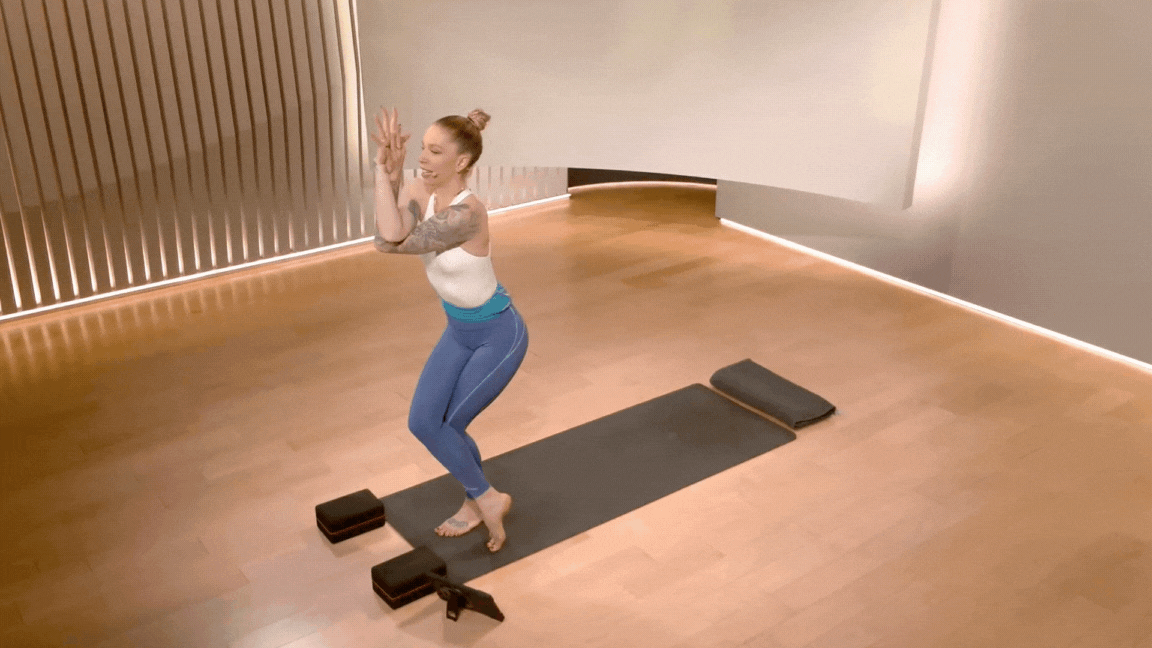
Milles Studio/Stocksy United
How to Do Eagle Pose, According to Yoga Experts
Eagle Pose looks like an advanced yoga posture, but there are modifications available for all levels.
By Jenny McCoy•
What Is Eagle Pose (Garudasana)?
What Muscles Does Eagle Pose Work?
What Are the Benefits of Eagle Pose?
How to Properly Do Eagle Pose
Eagle Pose Variations and Adjustments
Eagle Pose Mistakes to Avoid
Practice: Try a Yoga Sequence with Eagle Pose
Some yoga postures are more daunting than others, and for many beginners, Eagle Pose (Garudasana) sits at the top of the list. Although this posture is challenging, it’s more accessible than most people think. In truth, you don’t need next-level mobility or perfect balance to practice Eagle Pose or one of its variations.
With the help of three experts, including Peloton yoga instructor Mariana Fernández, we break down Eagle Pose, covering its benefits, instructions on how to do it correctly, helpful modifications, common mistakes to avoid, and more.
What Is Eagle Pose (Garudasana)?
Eagle Pose is a standing yoga posture that involves wrapping your arms together and your legs together while balancing on one foot. It’s truly a full body posture. “It requires your joints, muscles, alignment, and breath to work together," Mariana says.
Eagle Pose shows up in a variety of yoga styles, but it’s especially common in vinyasa yoga, which links fast-paced poses with your breath, and Hatha yoga, a slower style focused on deliberate movements. And because this posture requires a considerable amount of mobility and flexibility, instructors often cue it later in a class when your body is sufficiently warmed up. “Typically, you do Sun Salutations and other standing postures before getting into Eagle Pose,” says Tara Salay, a New York-based physical therapist and certified yoga instructor.

What Muscles Does Eagle Pose Work?
As Mariana mentioned, Eagle Pose works muscles throughout your body. Some of the main areas that the posture engages include:
Intrinsic foot muscles, which serve as your foundation as you balance on one leg
Hips, including your hip abductors (the muscles that move your legs to the side) and hip adductors (the muscles that bring your legs closer together) on your standing leg
Legs, primarily your quads
Core, especially your obliques (the muscles on the sides of your torso), transverse abdominis (a deep stabilizing muscle), and back muscles that provide spinal stability
Upper body muscles, including your deltoids (shoulders) and pecs (chest)
Although Eagle Pose may look like an intense stretch (and does, in fact, stretch your upper back), that’s actually not the focus, explains Jessica Klain, a Denver-based physical therapist and founder of Physio Yoga & Wellness. Rather, she explains that “it’s more of a balance pose.”
What Are the Benefits of Eagle Pose?
Regularly practicing Eagle Pose comes with a host of benefits. Here are some of the main ones:
Improves your balance. Doing the posture correctly involves standing still on one leg, which really challenges your balance. With continued practice, you can use Eagle Pose to improve your ability to hold steady.
Strengthens your core and legs. A variety of muscles need to fire up to help your body stay upright and stationary in Eagle Pose. So, it makes sense that regularly doing it can boost your strength levels, especially in your core and lower body, Salay says.
Increases your shoulder and hip mobility. To wrap your arm and leg correctly in Eagle Pose, you need to have good mobility in your shoulders, hips, and knees.
Builds breath awareness. “It's common to hold your breath in an effort to maintain balance in Eagle Pose,” Mariana says. But to experience the full expression of the pose, you should focus on breathing deeply into the backside of your body.
Stretches your upper back. The shoulder mobility required to practice Eagle Pose also helps you lengthen your upper back muscles, Klain says.

Peloton App
Access thousands of classes with no equipment needed.
How to Properly Do Eagle Pose

To experience all the amazing benefits of Eagle Pose (and stay safe in the process) proper form is essential. Follow these step-by-step instructions from our experts:
Start in Mountain Pose (Tadasana), standing with your feet together, legs straight, and arms down by your sides.
Shift your weight into your left foot.
Bend at both knees as you bring your right leg over your left thigh. If you have the necessary mobility, hook the top of your right foot behind your left calf. If this step doesn’t feel comfortable or natural, don’t force it.
Bring your arms in front of you, bending your elbows at 90 degrees. Cross your right arm under your left arm. Pull your elbows away from your body and lift them up, pointing your fingers upward. If you have the necessary mobility, wrap your hands so you’re pressing your palms together. Again, don’t force this step if it doesn’t feel right for your body.
Sink into the pose by bending deeper into your standing leg. Sit back into your standing hip as if you’re sitting in a chair (similar to Chair Pose, or Utkatasana in Sanskrit). Keep your spine straight and make sure to continuously inhale and exhale. Remain in this pose for the duration of three breaths. Over time, progress to holding the pose for five.
Release the pose and come back to Mountain Pose before repeating it on the other side, crossing your left leg over your right thigh.
Eagle Pose Variations and Adjustments
You don’t need to do the full expression of Eagle Pose to experience its benefits. In fact, there are a lot of people who simply can’t practice the traditional version, which is completely normal. “It's not uncommon for less flexible people or some older adults to just be unable to get into the full pose,” Klain says.
Even if it’s not in your practice to double wrap your arms or legs, Eagle Pose can still present a worthwhile strength and balance challenge. Here’s how to approach it in a few different scenarios:
What If I Can’t Wrap My Legs?
Don’t force the double leg wrap if it feels unnatural or uncomfortable. Instead, cross your top leg over your standing leg and hold the posture from there, allowing your foot to dangle, Klain says. You may find that this modification feels like even more of a balance and stability challenge than traditional Eagle Pose.
Another option, which is less balance-intensive, is to wrap your top leg over your standing leg’s shin and place the ball of your foot on the ground, Mariana says. Having your foot on the ground, like a kickstand, provides added stability.
What If I Can’t Wrap My Arms?
If you can’t bend your arms into the full double bind, try bringing one arm under the other, pulling your elbows away from your body, and lifting them up with your fingers pointing upward. Hold that position. From there, you can also try pressing the backs of your hands together.
Alternatively, Mariana says “a great modification for the arms is to give yourself a big hug,” as it “gives you the benefits of spreading through the shoulder blades and wrapping inward with the chest.”
How Do I Improve at Eagle Pose?
Keep in mind that Eagle Pose “is a tough pose from a mobility standpoint and not everybody's going to be capable of getting into that position,” Klain says. “That's completely OK.”
If getting closer to the traditional pose is a goal for you, there are a few things that can help. First, the posture demands a lot of shoulder and hip mobility, so work on improving your range of motion through these joints. To loosen your hips, Klain recommends practicing Pigeon Pose (Kapotasana), Lizard Pose (Utthan Pristhasana), Reclined Butterfly Pose (Supta Baddha Konasana), Low Lunge Pose, and High Lunge Pose. To open your shoulders, she suggests Cat-Cow Pose (Marjaryasana Bitilasana) and Puppy Dog Pose (Uttana Shishosana).
If you struggle to stay balanced in Eagle, work on boosting your stability by doing moves like Tree Pose (Vrksasana), Salay says.
Eagle Pose Mistakes to Avoid
To experience the full benefits of Eagle Pose, reduce your risk for injury, and feel good in the posture, steer clear of the following missteps:
Pushing too hard to wrap your arms or legs. Forcing the full expression of Eagle Pose when you don’t have the requisite mobility can cause joint issues, Klain warns. Listen to your body and be open to taking one of the expert-approved modifications above.
Holding your breath. Many people subconsciously hold their breath as they try to balance, but breathing into the backside of your body helps bring space to your spine, shoulders, and hips and releases tension in your joints, Mariana says. “Remember: If you wobble or fall out, you can always come back to the pose,” she says.
Digging your toes into the ground. You may grip the floor with your toes to help with balance, but doing so can create a bad habit that carries over to other functional activities, like walking, Klain says. Splay your toes out and find stability by engaging other muscles in your body.
Not fully engaging your muscles. It’s easy to let your muscles go lax while holding Eagle Pose, but to really build stability in the posture, think about staying tall through your spine, pulling your elbows up and away, and actively engaging your core.
Practice: Try a Yoga Sequence with Eagle Pose
Ready to practice Eagle Pose? Peloton App users can follow along with Peloton instructor Kirra Michel in this 20-Minute Focus Flow: Eagle. You’ll gently warm up your muscles and joints before moving through various postures that prepare you for Eagle Pose. If you don't have 20 minutes to spare, consider taking this 10-Minute Focus Flow: Eagle class with Dr. Chelsea Jackson Roberts, a Peloton yoga instructor.
This content is for informational and educational purposes only and does not constitute individualized advice. It is not intended to replace professional medical evaluation, diagnosis, or treatment. Seek the advice of your physician for questions you may have regarding your health or a medical condition. If you are having a medical emergency, call your physician or 911 immediately.
Want to strengthen your yoga practice?
We can help. Enter your email to get articles, instructor tips, and updates from Peloton sent to your inbox.
By providing your email address, you agree to receive marketing communications from Peloton.
For more about how we use your information, see our Privacy Policy.








